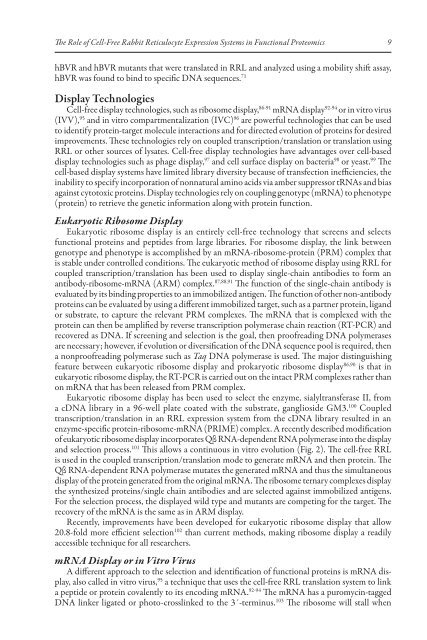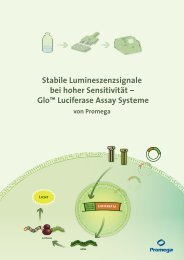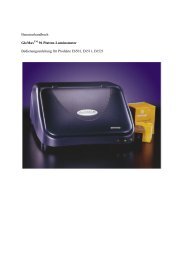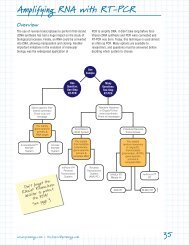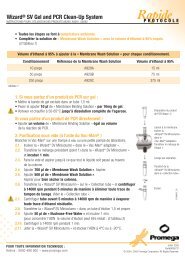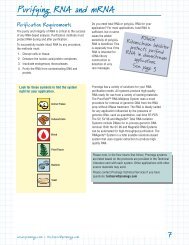The Role of Cell-Free Rabbit Reticulocyte Expression ... - Promega
The Role of Cell-Free Rabbit Reticulocyte Expression ... - Promega
The Role of Cell-Free Rabbit Reticulocyte Expression ... - Promega
You also want an ePaper? Increase the reach of your titles
YUMPU automatically turns print PDFs into web optimized ePapers that Google loves.
<strong>The</strong> <strong>Role</strong> <strong>of</strong> <strong>Cell</strong>-<strong>Free</strong> <strong>Rabbit</strong> <strong>Reticulocyte</strong> <strong>Expression</strong> Systems in Functional Proteomics<br />
hBVR and hBVR mutants that were translated in RRL and analyzed using a mobility shift assay,<br />
hBVR was found to bind to specific DNA sequences. 71<br />
Display Technologies<br />
<strong>Cell</strong>‑free display technologies, such as ribosome display, 86‑91 mRNA display 92‑94 or in vitro virus<br />
(IVV), 95 and in vitro compartmentalization (IVC) 96 are powerful technologies that can be used<br />
to identify protein‑target molecule interactions and for directed evolution <strong>of</strong> proteins for desired<br />
improvements. <strong>The</strong>se technologies rely on coupled transcription/translation or translation using<br />
RRL or other sources <strong>of</strong> lysates. <strong>Cell</strong>‑free display technologies have advantages over cell‑based<br />
display technologies such as phage display, 97 and cell surface display on bacteria 98 or yeast. 99 <strong>The</strong><br />
cell‑based display systems have limited library diversity because <strong>of</strong> transfection inefficiencies, the<br />
inability to specify incorporation <strong>of</strong> nonnatural amino acids via amber suppressor tRNAs and bias<br />
against cytotoxic proteins. Display technologies rely on coupling genotype (mRNA) to phenotype<br />
(protein) to retrieve the genetic information along with protein function.<br />
Eukaryotic Ribosome Display<br />
Eukaryotic ribosome display is an entirely cell‑free technology that screens and selects<br />
functional proteins and peptides from large libraries. For ribosome display, the link between<br />
genotype and phenotype is accomplished by an mRNA‑ribosome‑protein (PRM) complex that<br />
is stable under controlled conditions. <strong>The</strong> eukaryotic method <strong>of</strong> ribosome display using RRL for<br />
coupled transcription/translation has been used to display single‑chain antibodies to form an<br />
antibody‑ribosome‑mRNA (ARM) complex. 87,88,91 <strong>The</strong> function <strong>of</strong> the single‑chain antibody is<br />
evaluated by its binding properties to an immobilized antigen. <strong>The</strong> function <strong>of</strong> other non‑antibody<br />
proteins can be evaluated by using a different immobilized target, such as a partner protein, ligand<br />
or substrate, to capture the relevant PRM complexes. <strong>The</strong> mRNA that is complexed with the<br />
protein can then be amplified by reverse transcription polymerase chain reaction (RT‑PCR) and<br />
recovered as DNA. If screening and selection is the goal, then pro<strong>of</strong>reading DNA polymerases<br />
are necessary; however, if evolution or diversification <strong>of</strong> the DNA sequence pool is required, then<br />
a nonpro<strong>of</strong>reading polymerase such as Taq DNA polymerase is used. <strong>The</strong> major distinguishing<br />
feature between eukaryotic ribosome display and prokaryotic ribosome display 86,90 is that in<br />
eukaryotic ribosome display, the RT‑PCR is carried out on the intact PRM complexes rather than<br />
on mRNA that has been released from PRM complex.<br />
Eukaryotic ribosome display has been used to select the enzyme, sialyltransferase II, from<br />
a cDNA library in a 96‑well plate coated with the substrate, ganglioside GM3. 100 Coupled<br />
transcription/translation in an RRL expression system from the cDNA library resulted in an<br />
enzyme‑specific protein‑ribosome‑mRNA (PRIME) complex. A recently described modification<br />
<strong>of</strong> eukaryotic ribosome display incorporates Qβ RNA‑dependent RNA polymerase into the display<br />
and selection process. 101 This allows a continuous in vitro evolution (Fig. 2). <strong>The</strong> cell‑free RRL<br />
is used in the coupled transcription/translation mode to generate mRNA and then protein. <strong>The</strong><br />
Qβ RNA‑dependent RNA polymerase mutates the generated mRNA and thus the simultaneous<br />
display <strong>of</strong> the protein generated from the original mRNA. <strong>The</strong> ribosome ternary complexes display<br />
the synthesized proteins/single chain antibodies and are selected against immobilized antigens.<br />
For the selection process, the displayed wild type and mutants are competing for the target. <strong>The</strong><br />
recovery <strong>of</strong> the mRNA is the same as in ARM display.<br />
Recently, improvements have been developed for eukaryotic ribosome display that allow<br />
20.8‑fold more efficient selection 102 than current methods, making ribosome display a readily<br />
accessible technique for all researchers.<br />
mRNA Display or in Vitro Virus<br />
A different approach to the selection and identification <strong>of</strong> functional proteins is mRNA dis‑<br />
play, also called in vitro virus, 95 a technique that uses the cell‑free RRL translation system to link<br />
a peptide or protein covalently to its encoding mRNA. 92‑94 <strong>The</strong> mRNA has a puromycin‑tagged<br />
DNA linker ligated or photo‑crosslinked to the 3´‑terminus. 103 <strong>The</strong> ribosome will stall when


